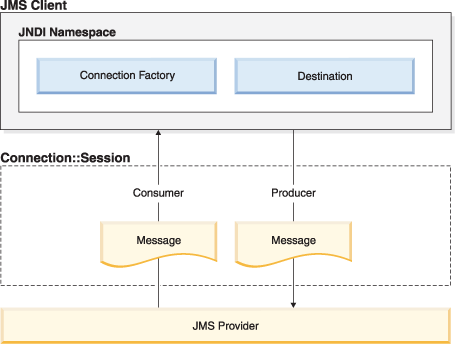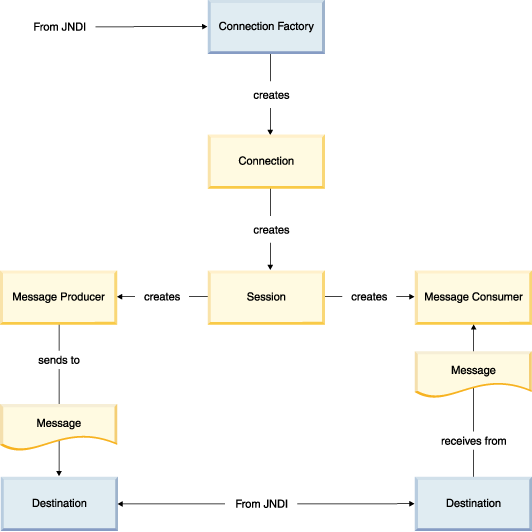IBM BPM, V8.0.1, All platforms > Authoring services in Integration Designer > Services and service-related functions > Access external services with messaging systems > Java Message Service (JMS)
Java Message Service (JMS) programming model
The JMS programming model is discussed in this section.
JMS defines an API for accessing services from a messaging provider; that is, it is not a product itself. It is a set of interface classes that messaging provider vendors implement. Applications that use the JMS API can then communicate with the messaging provider the vendor supplies. The JMS API has become the industry standard interface for Java™ applications to create, send, receive and read messages using messaging providers that support the JMS API. The standard is associated with the Java Platform, Enterprise Edition (Java EE) platform. Java EE is a set of standards for a component-based way to develop, assemble and deploy enterprise applications. Java EE containers implement a standard runtime environment that provides quality of service items such as security, transaction support and thread pooling.
In the following diagram, the JMS provider implements the JMS API. It is the entity with which the JMS client interacts. The JMS client establishes a connection and a session through which the interaction takes place. The JMS client establishes the connection based on configuration information in the connection factory and identifies where a message is to be sent to or retrieved from based on the destination. Both the connection factory and destination objects are listed in the Java Naming and Directory Interface (JNDI) namespace. JNDI is the Java industry standard API for accessing naming and directory services. Since the connection factory and destination are administered objects by JNDI, it means the JMS client can connect to different JMS providers without changing JMS client code; that is, it creates portability. It also means that attributes which often can and do change dynamically such as the destination can be changed independent of the JMS client code.

JMS has two messaging domains: point-to-point and publish-subscribe, which are the common ways of distributing messages. If that JMS lets an application send or receive messages in either domain. The following table shows the interfaces used by these domains.
In the following table, JNDI-administered interfaces are indicated by an asterisk.
| Common | Point-to-Point | Publish-Subscribe |
|---|---|---|
| ConnectionFactory * | QueueConnectionFactory * | TopicConnectionFactory * |
| Connection | QueueConnection | TopicConnection |
| Destination * | Queue * | Topic * |
| Session | QueueSession | TopicSession |
| MessageProducer | QueueSender | TopicPublisher |
| MessageConsumer | QueueReceiver, QueueBrowser | TopicSubscriber |
The JMS application is written to use only references to interfaces. Vendor-specific information is encapsulated in implementations of the following JMS administered objects: QueueConnectionFactory, TopicConnectionFactory, Queue and Topic.
These JMS administered objects are built using a vendor-supplied administration tool and stored on a JNDI namespace. A JMS application can retrieve these objects from the namespace and use them without needing to know which vendor provided the implementation.
At run time, the JMS client retrieves the connection factory (ConnectionFactory object) from a JNDI namespace and uses it to create a connection. The connection creates a session, which, in turn, creates a message producer or message consumer or both. The session also creates messages, which are sent to or retrieved from a destination (retrieved from a JNDI namespace) using the message producer and message consumer.

A recommended book that discusses JMS and its relationship to WebSphere in detail is  Enterprise Messaging Using JMS and IBM WebSphere by Kareem Yusuf.
Enterprise Messaging Using JMS and IBM WebSphere by Kareem Yusuf.